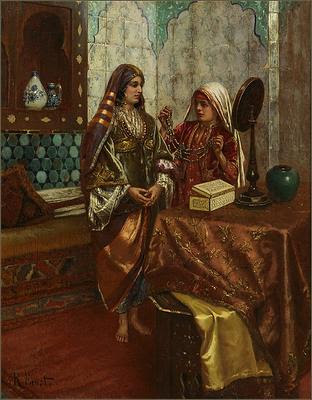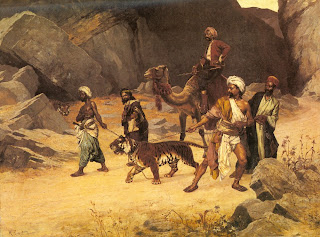Artist: Rudolf Ernst
Title: The Beggar
Signed lower right 'R. Ernst'
Medium:
Size:
Orientalist Paintings and Commentary on Orientalist Paintings by Rudolph Ernst

 Entering the Palace Garden
Entering the Palace Garden
A Sultan with a Tiger is one of several paintings loosely inspired by India (a country Ernst never visited), in which the artist reveals the extent to which he indulged his own and his audience's imaginations. It combines textiles from Europe and Asia, sculpture from India, tiles from North Africa, a modern Cairo-ware lamp, with a Nubian figure in Islamic dress. Typically, the picture includes just a single, exotically dressed figure, who is given added drama not only by the tiger, but also by Ernst's favorite compositional technique of depicting his subjects from a low perspective, heightening their grandeur and presence.
Source: Artfact
 Portrait of an Arab Nobleman
Portrait of an Arab Nobleman
(On this same trip, Ernst became fascinated by faience - a technique he would himself attempt). Noteworthy too are a series of pictures of Arab sentinels and other protectors, which feature elaborately costumed male figures standing guard at entrances to marble palaces, harems, and other sacrosanct spaces. Though the entire Austrian school of Orientalists seems to have had a fascination for such scenes, it was Ernst (and his friend Deutsch) who virtually monopolized the field and captured the public's attention. Indeed, even so popular a painter as Jean-Léon Gérôme could not compete with Ernst's barrage of textures and surfaces, and thanks to the liberal use of photographs, his exquisitely rendered and highly informative records of specific weapons and garments.
Though it can be considered a variation on the sentinel theme, the present picture is remarkable in Ernst's oeuvre - and not merely because of its size, which makes it one of Ernst's largest painted canvases. The bearded sitter has long been believed to be the Algerian leader and Arab folk hero Abd el Kadir (1808-1883), a figure well known to European audiences by the middle of the nineteenth century. Abd el Kadir's absolute resistance of foreign domination, driven in the name of his Islamic faith, had become a matter of international interest. In 1845, Horace Vernet (1780-1863) had exhibited his extraordinary The Taking of the Smalah of Abd el Kadir, a picture commissioned by the King in order to both reflect France's agenda of total conquest and to justify its continued outlay of revenue in Algeria. More specifically, and as the exhaustive livret described, the panoramic work depicts the surrender of Abd el Kadir to the Duke of Aumale, the son of Louis-Philippe, and 600 of his French horsemen. Of the 5000 Algerians who took part in the battle, 300 were killed and 3000 taken prisoner, including el Kadir himself.
After a period of imprisonment in France between 1847-1852, Abd el Kadir relocated to Damascus. There, in 1860, he was credited with saving the lives of an estimated 12,000 Christians, including the French consul and his staff, during a massacre instigated by local Ottoman officials. In an ironic historical twist, the French government conferred on their former nemesis the Grand Cordon of the Legion of Honour, and additional honours followed from a number of other European governments. Historical accounts remember Abd el Kadir first for his military exploits, but also for his immaculate white burnous, his friendship with many prominent European travellers, most notably Isabel and Richard Burton, and for his later poetry and scholarly and theological pursuits.
With the end of Abd el Kadir's self-proclaimed holy war against France in 1843, artists began to travel more frequently to Algeria. (Eugène Fromentin may be considered the first major European artist to venture to the region for an extended period of time.) While there is no record of a meeting between Abd el Kadir and Ernst, certain details of the artist's work seem to dovetail with this celebrated figure. The placement of the man's hand on the sword, for example, recalls Abd el Kadir's military accomplishments, while the open text below suggests his famed religious fervor. Ernst's care in choosing a startlingly white paint to render the man's robes, moreover, might be meant as a reminder of Abd el Kadir's distinctive dress. And certainly, compelling comparisons can be made between this bearded visage and that portrayed in other contemporary visual documents. But there are other details, as well, which suggest a far different interpretation: the ornate faience tiles in the background point to Ernst's own interests at the time, and the carved Koran stand, set among other exotic still life objects, is a motif that reappears in others of his paintings. Indeed, and despite the intriguing attribution regarding the identity of the sitter, this painting might be read as a reflection of Ernst's own career, and a cumulative memory of disparate Middle-Eastern travels.
Source: Emily Weeks wrote this essay for catalog entry for Artfact.
 The Guard of the Harem
The Guard of the Harem Returning Home
Returning Home
His exceptional mastery lies in his ability to combine layers of genuine artifacts in order to create outstanding fantasy. For instance, details like the 18th Century Ottoman sash tied around the Chieftain's waist juxtaposed with blue and green Moroccan tiles exemplify Ernst's skill in visually cross-referencing the archetypal designs of various regions in order to enhance his compositions. In An Elegant Chieftain in his Palace, Ernst decorates a regal Hispano-Moresque palace interior based on the Alhambra with objects most likely included in his own personal collection (as they were repeatedly included in his Orientalist compositions).
Similar to Lewis and Gerome, Ernst gathered a sizeable group of artifacts from his travels to the Middle East such as tiles, lamps, pottery, silks, satins and kaftans. The 17th Century Persian blue and white pot, for example, was also depicted in Un ciseleur and in Outside the Selim Tribe, Constantinople, as well as in The Perfume Makers. Furthermore, the 19th Century Syrian bronze lamp to the right of the Chieftain was depicted in After the Prayer and in The Wedding Day. The red and gold embroidered silk Damask curtain was also used in Smoking the Hookah, and the Moorish octagonal blue and green tiles were illustrated in Reading the Koran. The 19th Century Syrian mother-of-pearl inlaid table placed to the Chieftain's left is also depicted in the Refreshment (Najd Collection). The Alhambra-style background is a favorite setting that Ernst repeatedly returned to in his ambitious compositions such as The Wedding Day as well as The Moorish Guard, The Alhambra.
Source: Artfact
 Harem Girls
Harem Girls The Scholar
The Scholar The Presentation
The Presentation
In the present work it is evident from the nature of the item being presented - a sword - that the occasion is important, while the relative hierarchy between the two men is plain from their postures, their different positions on the steps up to the front door of the house and the relative richness of the draperies worn by them.
Yet to a Western eye as well (and it was for a Western clientel that the work was painted), Ernst also evokes a comfortingly bourgeois image of Middle Eastern life. Although grand, the architectural setting is domestic rather than palatial, and he paints the master of the house as wealthy rather than necessarily princely. Thus without losing the drama and the edge that so clearly came from experiencing the region at first hand, he presented to his prospective audience, most of whom had and never would visit themselves, a reassuringly familiar set of values, albeit wrapped in trappings distinct to the area. In the process, Ernst references all the elements that collectors required in such a work: the richly decorated ceramic tiles, the carpet, the marble and intricately carved window and door.
Source: Artfact
 The Metal Workers
The Metal Workers The Pasha's Favorite Tiger
The Pasha's Favorite Tiger The Wedding Gift
The Wedding Gift The Perfume Maker
The Perfume Maker The Arab Prince
The Arab Prince Moorish Interior
Moorish Interior The Moorish Guard
The Moorish Guard Return from the Tiger Hunt
Return from the Tiger Hunt
Ernst belonged to the second generation of Orientalist painters. The first generation, such as Delacroix, Vernet, Colin and Chasseriau were inspired by political events such as the liberation of Greece and Napoleon's conquest of Algeria. Artists from the second half of the century such as Gerome, Bauernfeind, Deutsch and Ernst were more interested in depicting scenes from the daily life of the East such as Bedouins gathering in sun bathed deserts, Bashi-Bazouks resting, Nubians guarding palaces or odalisques smoking narghiles in intimate harems. Ernst's first taste of the East was sparked by journeys to Moorish Spain, Morocco and Tunis and later to Constantinople and Egypt.
Whilst on these travels he became very interested in the eastern styles of decoration, in particular tile-making, and by 1900 he left Paris to live in Fontenay-aux-Roses, where he decorated his home in an Ottoman style and lived among the oriental objects which figured so largely in his paintings. In fact, he even painted wearing the tasseled cap known as a tarboosh. Heavily influenced by the academic style of Jean-Leon Gerome, both Ludwig Deutsch and Rudolf Ernst implemented the French master's exactitude in detail and intensity of color. Yet Ernst's work differs fundamentally when compared to both Gerome and Deutsch, as his compositions are eclectic assemblies and wondrous compilations of selected designs from different sources such as Algeria, Tunisia, Turkey and Andalusian Spain.
Source: Artfact